Inventions and Innovations
VerifiedAdded on 2022/03/15
|18
|5150
|422
AI Summary
Comparre invention of technological, major innovation and minor innovation 4 2.L. Theory of Von Hippel and functional sources of innovation: 7 2.1. The interaction of technology and business performance in making Ford's Model T 9 4. The interaction of technology and business performance in making Ford's Model T 9 4.
Contribute Materials
Your contribution can guide someone’s learning journey. Share your
documents today.
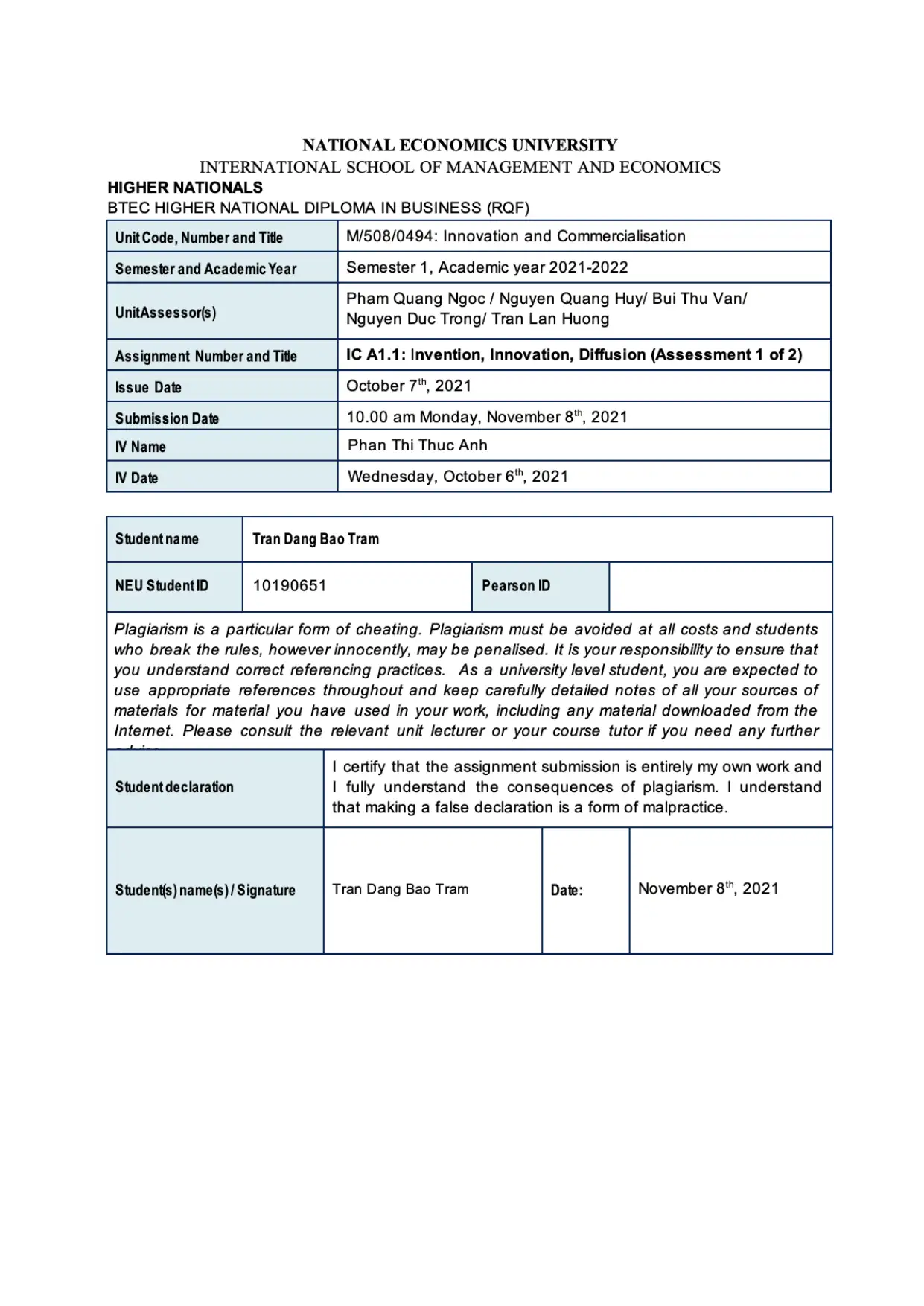
Secure Best Marks with AI Grader
Need help grading? Try our AI Grader for instant feedback on your assignments.

Table of Contents
INTRODUCTION.................................................................................................................... 3
MAJOR FINDINGS................................................................................................................ 4
1. Inventions and innovations.....................................................................................4
1.1. Invention........................................................................................................4
1.2. Innovation......................................................................................................4
1.3. Comparre invention of technological, major innovation and minor
innovation.................................................................................................................... 4
2. Theory of Von Hippel and functional sources of innovation:....................................7
2.1. The theory of Von Hipple..............................................................................7
2.2. Evaluate how these sources of innovation help the firm to generate new-
product innovations....................................................................................................7
3. Technology push and Demand Pull........................................................................8
3.1. Definition of demand pull and technology push.........................................8
3.2. Using the models of demand-pull and/or technological push...................8
3.3. The interaction of technology and business performance in making
Ford's Model T............................................................................................................. 9
4. Vision, leadership, culture of Ford...........................................................................9
5. Analyze the competition between Ford’ Model T and Morris Motors’ cars.............10
5.1. The S-curves...............................................................................................11
5.2. The performance of Ford’s Model T..................................................................11
5.3. Rival technology.................................................................................................12
5.4. Did Ford still enjoy performance or cost advantage?.....................................12
5.4. 4Ps innovation of Ford.......................................................................................13
5.5. Innovation funnel of Ford..................................................................................13
6. The success of Ford and frugal innovation...........................................................15
6.1. The success of Ford...................................................................................15
6.2. Technology innovation management of Ford...........................................15
6.3. Frugal innovation........................................................................................15
CONCLUSION.....................................................................................................................17
REFERENCES.....................................................................................................................18
INTRODUCTION.................................................................................................................... 3
MAJOR FINDINGS................................................................................................................ 4
1. Inventions and innovations.....................................................................................4
1.1. Invention........................................................................................................4
1.2. Innovation......................................................................................................4
1.3. Comparre invention of technological, major innovation and minor
innovation.................................................................................................................... 4
2. Theory of Von Hippel and functional sources of innovation:....................................7
2.1. The theory of Von Hipple..............................................................................7
2.2. Evaluate how these sources of innovation help the firm to generate new-
product innovations....................................................................................................7
3. Technology push and Demand Pull........................................................................8
3.1. Definition of demand pull and technology push.........................................8
3.2. Using the models of demand-pull and/or technological push...................8
3.3. The interaction of technology and business performance in making
Ford's Model T............................................................................................................. 9
4. Vision, leadership, culture of Ford...........................................................................9
5. Analyze the competition between Ford’ Model T and Morris Motors’ cars.............10
5.1. The S-curves...............................................................................................11
5.2. The performance of Ford’s Model T..................................................................11
5.3. Rival technology.................................................................................................12
5.4. Did Ford still enjoy performance or cost advantage?.....................................12
5.4. 4Ps innovation of Ford.......................................................................................13
5.5. Innovation funnel of Ford..................................................................................13
6. The success of Ford and frugal innovation...........................................................15
6.1. The success of Ford...................................................................................15
6.2. Technology innovation management of Ford...........................................15
6.3. Frugal innovation........................................................................................15
CONCLUSION.....................................................................................................................17
REFERENCES.....................................................................................................................18

INTRODUCTION
This paper will provide an overview of the automobile industry's evolution from the beginning
to the present. Furthermore, the distinction between invention and creativity, as well as other
forms of innovation, are discussed in this paper. Rivals in the automotive business are also
scrutinized.
MAJOR FINDINGS
1. Inventions and innovations
1.1. Invention
This paper will provide an overview of the automobile industry's evolution from the beginning
to the present. Furthermore, the distinction between invention and creativity, as well as other
forms of innovation, are discussed in this paper. Rivals in the automotive business are also
scrutinized.
MAJOR FINDINGS
1. Inventions and innovations
1.1. Invention

According to Schumpeter (1934), invention is described as the systematic
transformation of novel ideas into technology. Furthermore, invention refers to the
process of developing a product or service that is distinct from what is already available
(Miettinen, 1996).
1.2. Innovation
Innovation is defined as the transformation of previously unmarketable ideas into
commercially viable products (Schumpeter, 1934).
1.3. Comparre invention of technological, major innovation
and minor innovation
Invention of technology breakthroughts: are invention-based inventions that serve
as the foundation for a wide range of following technical advancements (Kerr, 2009).
Major innovation: is a business concept that aims to fully demolish and replace a
current industry or develop an entirely new one (Peter, D., 1985). When they were
originally brought to the market, great innovations seldom reached their full potential
(Taylor, 2017).
Minor/ incremental innovation: refers to the little adjustments made to a product in
order to improve performance, decrease costs, and expand the product's desirable
qualities (Norman and Verganti, 2014).
Time Name /
Description Description Invention Innovation Inventor/
Innovator
Types of
innovation
1859
The internal
combustion engine
was improved.
Boats, railroads, and
bicycles were the first
vehicles to use internal
combustion engines,
which eventually
replaced steam engines
(situation, 3)
x Frenchma
n Lenoir
1869
Celluloid (a
commercial
success)
The majority of today's
plastics are made from
polymers, which are
once again the principal
raw material (situation,
7).
x J.W. Hyatt Major
Innovation
1896 First ‘horseless
carriage’
The name given to a car
or motor vehicle when it
x Henry
Ford
transformation of novel ideas into technology. Furthermore, invention refers to the
process of developing a product or service that is distinct from what is already available
(Miettinen, 1996).
1.2. Innovation
Innovation is defined as the transformation of previously unmarketable ideas into
commercially viable products (Schumpeter, 1934).
1.3. Comparre invention of technological, major innovation
and minor innovation
Invention of technology breakthroughts: are invention-based inventions that serve
as the foundation for a wide range of following technical advancements (Kerr, 2009).
Major innovation: is a business concept that aims to fully demolish and replace a
current industry or develop an entirely new one (Peter, D., 1985). When they were
originally brought to the market, great innovations seldom reached their full potential
(Taylor, 2017).
Minor/ incremental innovation: refers to the little adjustments made to a product in
order to improve performance, decrease costs, and expand the product's desirable
qualities (Norman and Verganti, 2014).
Time Name /
Description Description Invention Innovation Inventor/
Innovator
Types of
innovation
1859
The internal
combustion engine
was improved.
Boats, railroads, and
bicycles were the first
vehicles to use internal
combustion engines,
which eventually
replaced steam engines
(situation, 3)
x Frenchma
n Lenoir
1869
Celluloid (a
commercial
success)
The majority of today's
plastics are made from
polymers, which are
once again the principal
raw material (situation,
7).
x J.W. Hyatt Major
Innovation
1896 First ‘horseless
carriage’
The name given to a car
or motor vehicle when it
x Henry
Ford
Secure Best Marks with AI Grader
Need help grading? Try our AI Grader for instant feedback on your assignments.
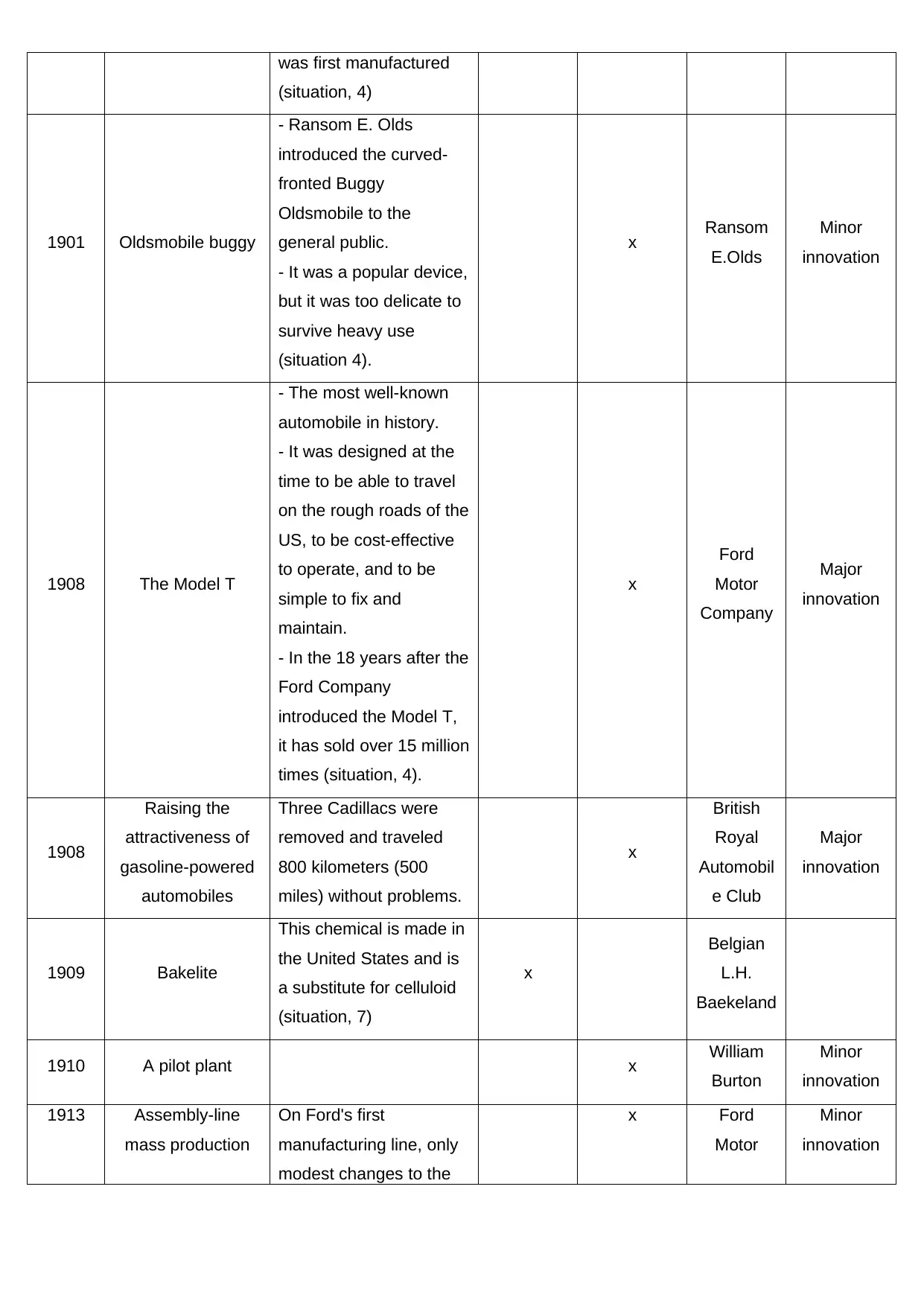
was first manufactured
(situation, 4)
1901 Oldsmobile buggy
- Ransom E. Olds
introduced the curved-
fronted Buggy
Oldsmobile to the
general public.
- It was a popular device,
but it was too delicate to
survive heavy use
(situation 4).
x Ransom
E.Olds
Minor
innovation
1908 The Model T
- The most well-known
automobile in history.
- It was designed at the
time to be able to travel
on the rough roads of the
US, to be cost-effective
to operate, and to be
simple to fix and
maintain.
- In the 18 years after the
Ford Company
introduced the Model T,
it has sold over 15 million
times (situation, 4).
x
Ford
Motor
Company
Major
innovation
1908
Raising the
attractiveness of
gasoline-powered
automobiles
Three Cadillacs were
removed and traveled
800 kilometers (500
miles) without problems.
x
British
Royal
Automobil
e Club
Major
innovation
1909 Bakelite
This chemical is made in
the United States and is
a substitute for celluloid
(situation, 7)
x
Belgian
L.H.
Baekeland
1910 A pilot plant x William
Burton
Minor
innovation
1913 Assembly-line
mass production
On Ford's first
manufacturing line, only
modest changes to the
x Ford
Motor
Minor
innovation
(situation, 4)
1901 Oldsmobile buggy
- Ransom E. Olds
introduced the curved-
fronted Buggy
Oldsmobile to the
general public.
- It was a popular device,
but it was too delicate to
survive heavy use
(situation 4).
x Ransom
E.Olds
Minor
innovation
1908 The Model T
- The most well-known
automobile in history.
- It was designed at the
time to be able to travel
on the rough roads of the
US, to be cost-effective
to operate, and to be
simple to fix and
maintain.
- In the 18 years after the
Ford Company
introduced the Model T,
it has sold over 15 million
times (situation, 4).
x
Ford
Motor
Company
Major
innovation
1908
Raising the
attractiveness of
gasoline-powered
automobiles
Three Cadillacs were
removed and traveled
800 kilometers (500
miles) without problems.
x
British
Royal
Automobil
e Club
Major
innovation
1909 Bakelite
This chemical is made in
the United States and is
a substitute for celluloid
(situation, 7)
x
Belgian
L.H.
Baekeland
1910 A pilot plant x William
Burton
Minor
innovation
1913 Assembly-line
mass production
On Ford's first
manufacturing line, only
modest changes to the
x Ford
Motor
Minor
innovation
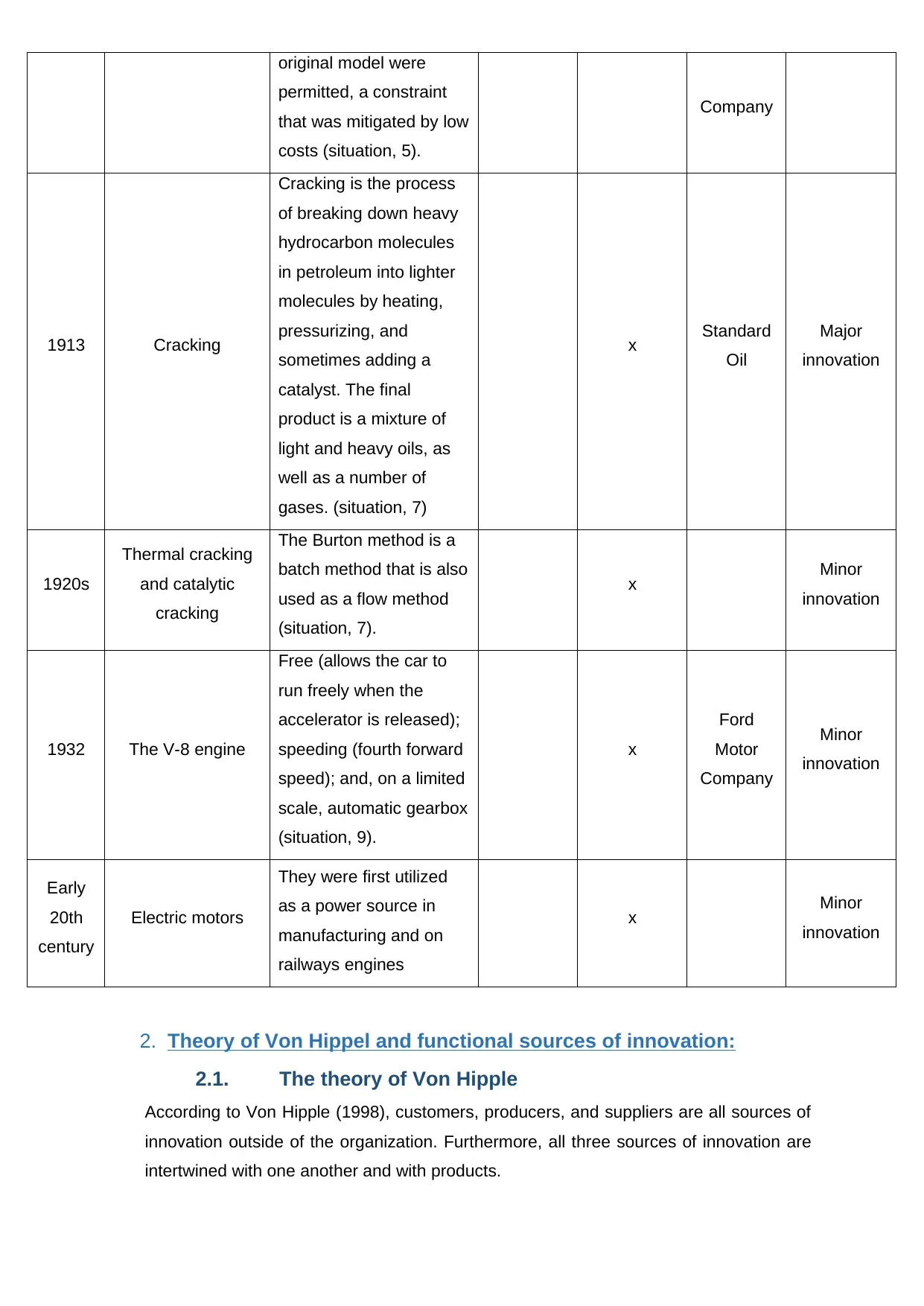
original model were
permitted, a constraint
that was mitigated by low
costs (situation, 5).
Company
1913 Cracking
Cracking is the process
of breaking down heavy
hydrocarbon molecules
in petroleum into lighter
molecules by heating,
pressurizing, and
sometimes adding a
catalyst. The final
product is a mixture of
light and heavy oils, as
well as a number of
gases. (situation, 7)
x Standard
Oil
Major
innovation
1920s
Thermal cracking
and catalytic
cracking
The Burton method is a
batch method that is also
used as a flow method
(situation, 7).
x Minor
innovation
1932 The V-8 engine
Free (allows the car to
run freely when the
accelerator is released);
speeding (fourth forward
speed); and, on a limited
scale, automatic gearbox
(situation, 9).
x
Ford
Motor
Company
Minor
innovation
Early
20th
century
Electric motors
They were first utilized
as a power source in
manufacturing and on
railways engines
x Minor
innovation
2. Theory of Von Hippel and functional sources of innovation:
2.1. The theory of Von Hipple
According to Von Hipple (1998), customers, producers, and suppliers are all sources of
innovation outside of the organization. Furthermore, all three sources of innovation are
intertwined with one another and with products.
permitted, a constraint
that was mitigated by low
costs (situation, 5).
Company
1913 Cracking
Cracking is the process
of breaking down heavy
hydrocarbon molecules
in petroleum into lighter
molecules by heating,
pressurizing, and
sometimes adding a
catalyst. The final
product is a mixture of
light and heavy oils, as
well as a number of
gases. (situation, 7)
x Standard
Oil
Major
innovation
1920s
Thermal cracking
and catalytic
cracking
The Burton method is a
batch method that is also
used as a flow method
(situation, 7).
x Minor
innovation
1932 The V-8 engine
Free (allows the car to
run freely when the
accelerator is released);
speeding (fourth forward
speed); and, on a limited
scale, automatic gearbox
(situation, 9).
x
Ford
Motor
Company
Minor
innovation
Early
20th
century
Electric motors
They were first utilized
as a power source in
manufacturing and on
railways engines
x Minor
innovation
2. Theory of Von Hippel and functional sources of innovation:
2.1. The theory of Von Hipple
According to Von Hipple (1998), customers, producers, and suppliers are all sources of
innovation outside of the organization. Furthermore, all three sources of innovation are
intertwined with one another and with products.
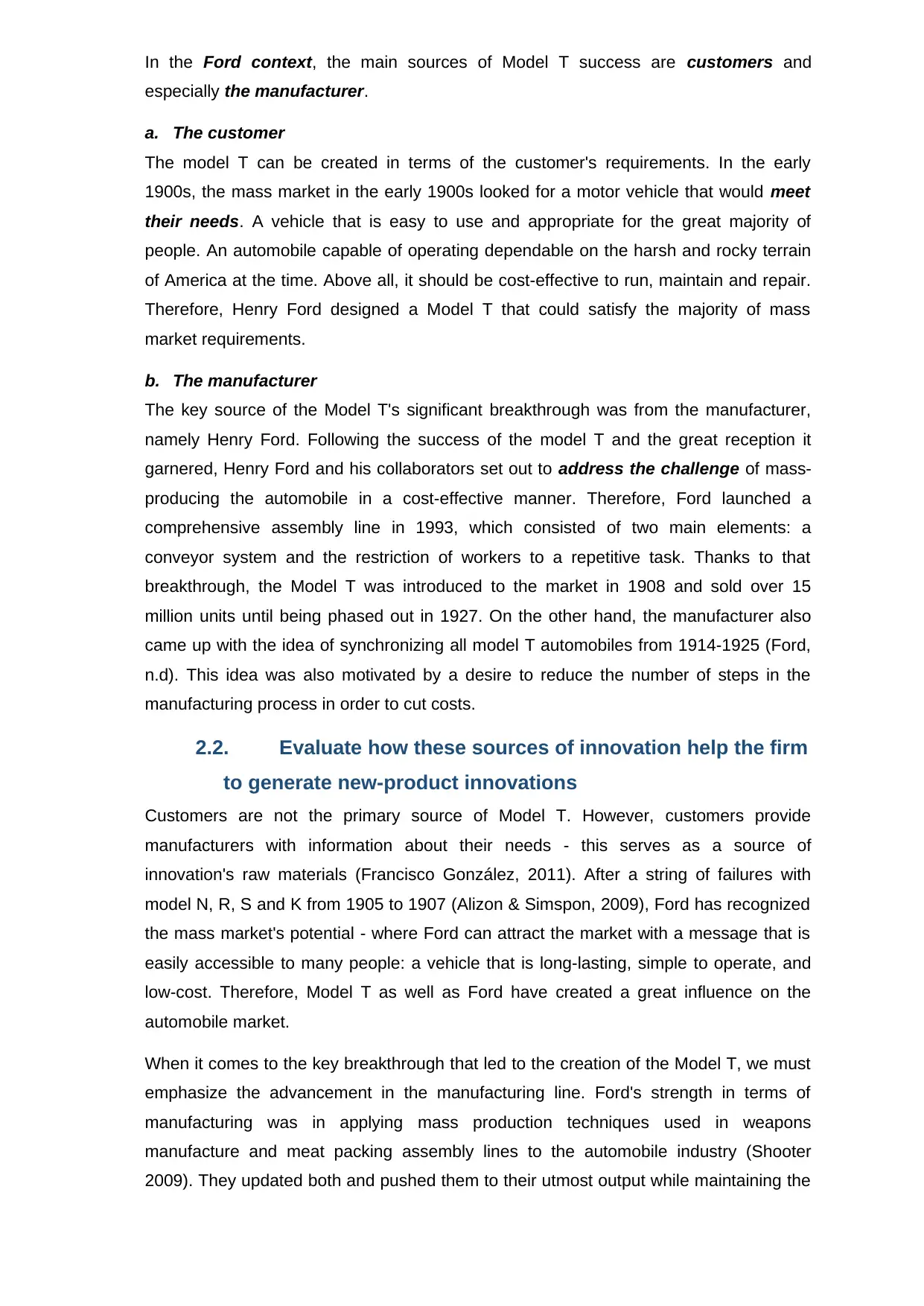
In the Ford context, the main sources of Model T success are customers and
especially the manufacturer.
a. The customer
The model T can be created in terms of the customer's requirements. In the early
1900s, the mass market in the early 1900s looked for a motor vehicle that would meet
their needs. A vehicle that is easy to use and appropriate for the great majority of
people. An automobile capable of operating dependable on the harsh and rocky terrain
of America at the time. Above all, it should be cost-effective to run, maintain and repair.
Therefore, Henry Ford designed a Model T that could satisfy the majority of mass
market requirements.
b. The manufacturer
The key source of the Model T's significant breakthrough was from the manufacturer,
namely Henry Ford. Following the success of the model T and the great reception it
garnered, Henry Ford and his collaborators set out to address the challenge of mass-
producing the automobile in a cost-effective manner. Therefore, Ford launched a
comprehensive assembly line in 1993, which consisted of two main elements: a
conveyor system and the restriction of workers to a repetitive task. Thanks to that
breakthrough, the Model T was introduced to the market in 1908 and sold over 15
million units until being phased out in 1927. On the other hand, the manufacturer also
came up with the idea of synchronizing all model T automobiles from 1914-1925 (Ford,
n.d). This idea was also motivated by a desire to reduce the number of steps in the
manufacturing process in order to cut costs.
2.2. Evaluate how these sources of innovation help the firm
to generate new-product innovations
Customers are not the primary source of Model T. However, customers provide
manufacturers with information about their needs - this serves as a source of
innovation's raw materials (Francisco González, 2011). After a string of failures with
model N, R, S and K from 1905 to 1907 (Alizon & Simspon, 2009), Ford has recognized
the mass market's potential - where Ford can attract the market with a message that is
easily accessible to many people: a vehicle that is long-lasting, simple to operate, and
low-cost. Therefore, Model T as well as Ford have created a great influence on the
automobile market.
When it comes to the key breakthrough that led to the creation of the Model T, we must
emphasize the advancement in the manufacturing line. Ford's strength in terms of
manufacturing was in applying mass production techniques used in weapons
manufacture and meat packing assembly lines to the automobile industry (Shooter
2009). They updated both and pushed them to their utmost output while maintaining the
especially the manufacturer.
a. The customer
The model T can be created in terms of the customer's requirements. In the early
1900s, the mass market in the early 1900s looked for a motor vehicle that would meet
their needs. A vehicle that is easy to use and appropriate for the great majority of
people. An automobile capable of operating dependable on the harsh and rocky terrain
of America at the time. Above all, it should be cost-effective to run, maintain and repair.
Therefore, Henry Ford designed a Model T that could satisfy the majority of mass
market requirements.
b. The manufacturer
The key source of the Model T's significant breakthrough was from the manufacturer,
namely Henry Ford. Following the success of the model T and the great reception it
garnered, Henry Ford and his collaborators set out to address the challenge of mass-
producing the automobile in a cost-effective manner. Therefore, Ford launched a
comprehensive assembly line in 1993, which consisted of two main elements: a
conveyor system and the restriction of workers to a repetitive task. Thanks to that
breakthrough, the Model T was introduced to the market in 1908 and sold over 15
million units until being phased out in 1927. On the other hand, the manufacturer also
came up with the idea of synchronizing all model T automobiles from 1914-1925 (Ford,
n.d). This idea was also motivated by a desire to reduce the number of steps in the
manufacturing process in order to cut costs.
2.2. Evaluate how these sources of innovation help the firm
to generate new-product innovations
Customers are not the primary source of Model T. However, customers provide
manufacturers with information about their needs - this serves as a source of
innovation's raw materials (Francisco González, 2011). After a string of failures with
model N, R, S and K from 1905 to 1907 (Alizon & Simspon, 2009), Ford has recognized
the mass market's potential - where Ford can attract the market with a message that is
easily accessible to many people: a vehicle that is long-lasting, simple to operate, and
low-cost. Therefore, Model T as well as Ford have created a great influence on the
automobile market.
When it comes to the key breakthrough that led to the creation of the Model T, we must
emphasize the advancement in the manufacturing line. Ford's strength in terms of
manufacturing was in applying mass production techniques used in weapons
manufacture and meat packing assembly lines to the automobile industry (Shooter
2009). They updated both and pushed them to their utmost output while maintaining the
Paraphrase This Document
Need a fresh take? Get an instant paraphrase of this document with our AI Paraphraser
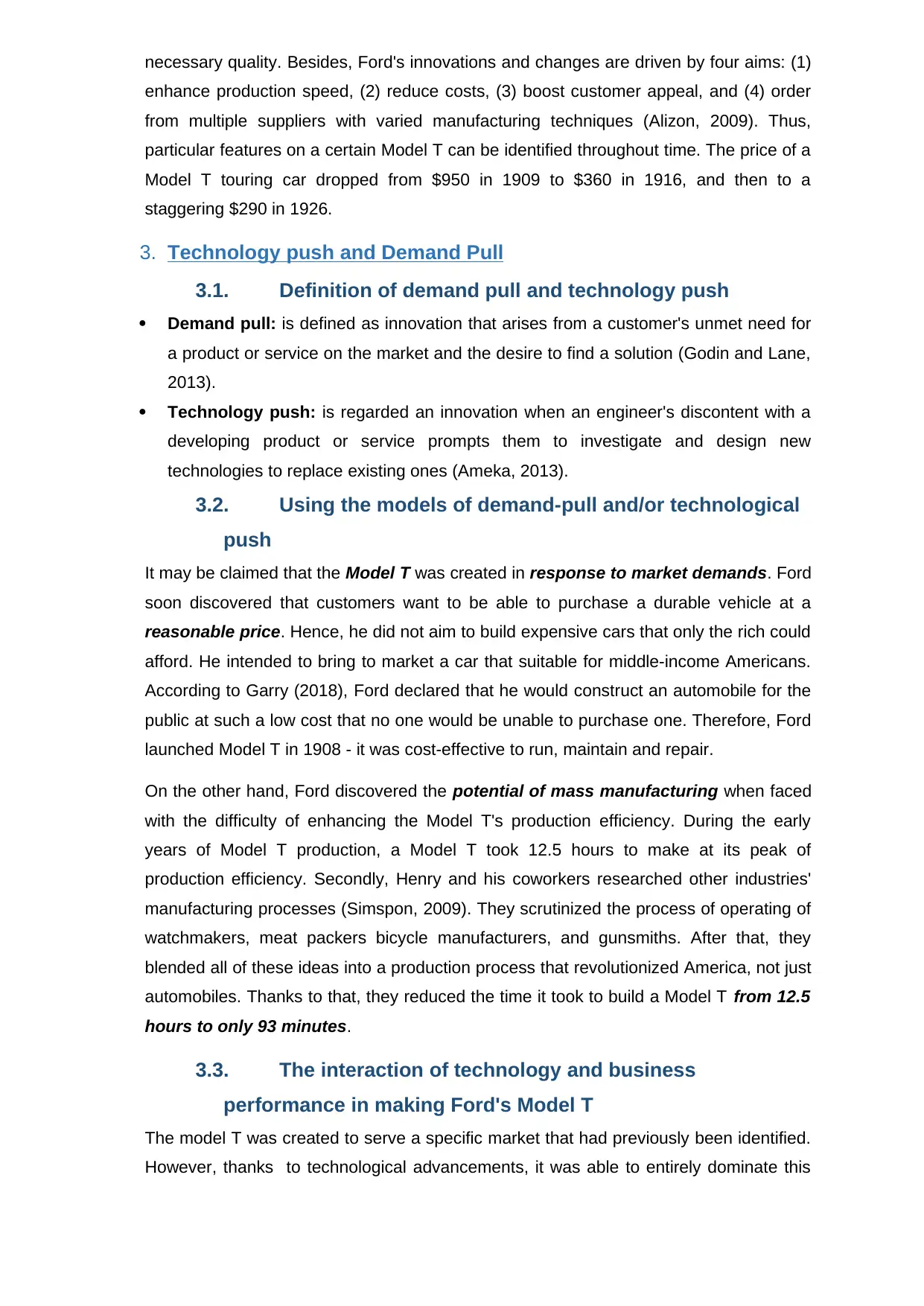
necessary quality. Besides, Ford's innovations and changes are driven by four aims: (1)
enhance production speed, (2) reduce costs, (3) boost customer appeal, and (4) order
from multiple suppliers with varied manufacturing techniques (Alizon, 2009). Thus,
particular features on a certain Model T can be identified throughout time. The price of a
Model T touring car dropped from $950 in 1909 to $360 in 1916, and then to a
staggering $290 in 1926.
3. Technology push and Demand Pull
3.1. Definition of demand pull and technology push
Demand pull: is defined as innovation that arises from a customer's unmet need for
a product or service on the market and the desire to find a solution (Godin and Lane,
2013).
Technology push: is regarded an innovation when an engineer's discontent with a
developing product or service prompts them to investigate and design new
technologies to replace existing ones (Ameka, 2013).
3.2. Using the models of demand-pull and/or technological
push
It may be claimed that the Model T was created in response to market demands. Ford
soon discovered that customers want to be able to purchase a durable vehicle at a
reasonable price. Hence, he did not aim to build expensive cars that only the rich could
afford. He intended to bring to market a car that suitable for middle-income Americans.
According to Garry (2018), Ford declared that he would construct an automobile for the
public at such a low cost that no one would be unable to purchase one. Therefore, Ford
launched Model T in 1908 - it was cost-effective to run, maintain and repair.
On the other hand, Ford discovered the potential of mass manufacturing when faced
with the difficulty of enhancing the Model T's production efficiency. During the early
years of Model T production, a Model T took 12.5 hours to make at its peak of
production efficiency. Secondly, Henry and his coworkers researched other industries'
manufacturing processes (Simspon, 2009). They scrutinized the process of operating of
watchmakers, meat packers bicycle manufacturers, and gunsmiths. After that, they
blended all of these ideas into a production process that revolutionized America, not just
automobiles. Thanks to that, they reduced the time it took to build a Model T from 12.5
hours to only 93 minutes.
3.3. The interaction of technology and business
performance in making Ford's Model T
The model T was created to serve a specific market that had previously been identified.
However, thanks to technological advancements, it was able to entirely dominate this
enhance production speed, (2) reduce costs, (3) boost customer appeal, and (4) order
from multiple suppliers with varied manufacturing techniques (Alizon, 2009). Thus,
particular features on a certain Model T can be identified throughout time. The price of a
Model T touring car dropped from $950 in 1909 to $360 in 1916, and then to a
staggering $290 in 1926.
3. Technology push and Demand Pull
3.1. Definition of demand pull and technology push
Demand pull: is defined as innovation that arises from a customer's unmet need for
a product or service on the market and the desire to find a solution (Godin and Lane,
2013).
Technology push: is regarded an innovation when an engineer's discontent with a
developing product or service prompts them to investigate and design new
technologies to replace existing ones (Ameka, 2013).
3.2. Using the models of demand-pull and/or technological
push
It may be claimed that the Model T was created in response to market demands. Ford
soon discovered that customers want to be able to purchase a durable vehicle at a
reasonable price. Hence, he did not aim to build expensive cars that only the rich could
afford. He intended to bring to market a car that suitable for middle-income Americans.
According to Garry (2018), Ford declared that he would construct an automobile for the
public at such a low cost that no one would be unable to purchase one. Therefore, Ford
launched Model T in 1908 - it was cost-effective to run, maintain and repair.
On the other hand, Ford discovered the potential of mass manufacturing when faced
with the difficulty of enhancing the Model T's production efficiency. During the early
years of Model T production, a Model T took 12.5 hours to make at its peak of
production efficiency. Secondly, Henry and his coworkers researched other industries'
manufacturing processes (Simspon, 2009). They scrutinized the process of operating of
watchmakers, meat packers bicycle manufacturers, and gunsmiths. After that, they
blended all of these ideas into a production process that revolutionized America, not just
automobiles. Thanks to that, they reduced the time it took to build a Model T from 12.5
hours to only 93 minutes.
3.3. The interaction of technology and business
performance in making Ford's Model T
The model T was created to serve a specific market that had previously been identified.
However, thanks to technological advancements, it was able to entirely dominate this

market. This manufacturing process has revolutionized the manufacturing industry in the
United States (Chen, Kan, 1984). The breakthrough in the manufacturing line has
increased the T-production model's efficiency, lowering input costs, increasing selling
prices, and meeting market demands. Automobile prices plummeted as well, from $950
in 1909 to $290 in 1926. Ford was responsible for half of all automobiles in the world
by this time. Therefore, both demand pull and technological push have had a positive
impact on Ford’s innovation and business.
4. Vision, leadership, culture of Ford.
a, Vision
“One Ford, one team, one plan and one goal”, according to a report of Ford Motor
Company. It can be seen that the person who created the revolution and glory for Ford
is Henry Ford. In reality, Henry Ford quit after multiple failed efforts. A few others,
though, continue to believe in him (Mohammed, n.d.). Henry Ford demonstrated that his
followers' trust in him was not misplaced by continuing his work. Following the prospects
of the model A automobile in 1903, Henry Ford successfully sought the perfect model T
in 1908, resulting in a magnificent history for Ford. With many positive receptions from
customers, Ford pursued the development of a mass manufacturing line, a technique
that enabled the model T's production to be raised to a new level. For over two decades,
Ford concentrated completely on the Model T, producing 15 million automobiles to meet
market demand. Therefore, the model T's development history demonstrates that Ford's
vision has been completely realized.
b, Leadership
Due to Henry Ford's authoritarian leadership style, he was able to optimize the Model T
production line to meet market demands. Although Henry Ford's authoritarian leadership
caused controversy in creating a production line that stressed and limited the creativity
of employees, it was still the right decision at the time. That is to increase productivity as
much as possible and make the Model T successful. Although this leadership sparked
debate by constructing a manufacturing line that strained and limited people' creativity, it
was the appropriate move at the time. This has played a significant role in maximizing
production and ensuring the Model T's success.
c, Cultural
Ford's culture was deemed claustrophobic before and throughout the production of the
Model T. According to Kiley (2007), Ford was focused on short-term profitability rather
than long-term strategy since his family relied on dividend income. There was the
formation of a bureaucracy. As a result, at this juncture, managers and executives were
"pitting themselves against one another like gladiators to prove themselves" (Kiley,
United States (Chen, Kan, 1984). The breakthrough in the manufacturing line has
increased the T-production model's efficiency, lowering input costs, increasing selling
prices, and meeting market demands. Automobile prices plummeted as well, from $950
in 1909 to $290 in 1926. Ford was responsible for half of all automobiles in the world
by this time. Therefore, both demand pull and technological push have had a positive
impact on Ford’s innovation and business.
4. Vision, leadership, culture of Ford.
a, Vision
“One Ford, one team, one plan and one goal”, according to a report of Ford Motor
Company. It can be seen that the person who created the revolution and glory for Ford
is Henry Ford. In reality, Henry Ford quit after multiple failed efforts. A few others,
though, continue to believe in him (Mohammed, n.d.). Henry Ford demonstrated that his
followers' trust in him was not misplaced by continuing his work. Following the prospects
of the model A automobile in 1903, Henry Ford successfully sought the perfect model T
in 1908, resulting in a magnificent history for Ford. With many positive receptions from
customers, Ford pursued the development of a mass manufacturing line, a technique
that enabled the model T's production to be raised to a new level. For over two decades,
Ford concentrated completely on the Model T, producing 15 million automobiles to meet
market demand. Therefore, the model T's development history demonstrates that Ford's
vision has been completely realized.
b, Leadership
Due to Henry Ford's authoritarian leadership style, he was able to optimize the Model T
production line to meet market demands. Although Henry Ford's authoritarian leadership
caused controversy in creating a production line that stressed and limited the creativity
of employees, it was still the right decision at the time. That is to increase productivity as
much as possible and make the Model T successful. Although this leadership sparked
debate by constructing a manufacturing line that strained and limited people' creativity, it
was the appropriate move at the time. This has played a significant role in maximizing
production and ensuring the Model T's success.
c, Cultural
Ford's culture was deemed claustrophobic before and throughout the production of the
Model T. According to Kiley (2007), Ford was focused on short-term profitability rather
than long-term strategy since his family relied on dividend income. There was the
formation of a bureaucracy. As a result, at this juncture, managers and executives were
"pitting themselves against one another like gladiators to prove themselves" (Kiley,
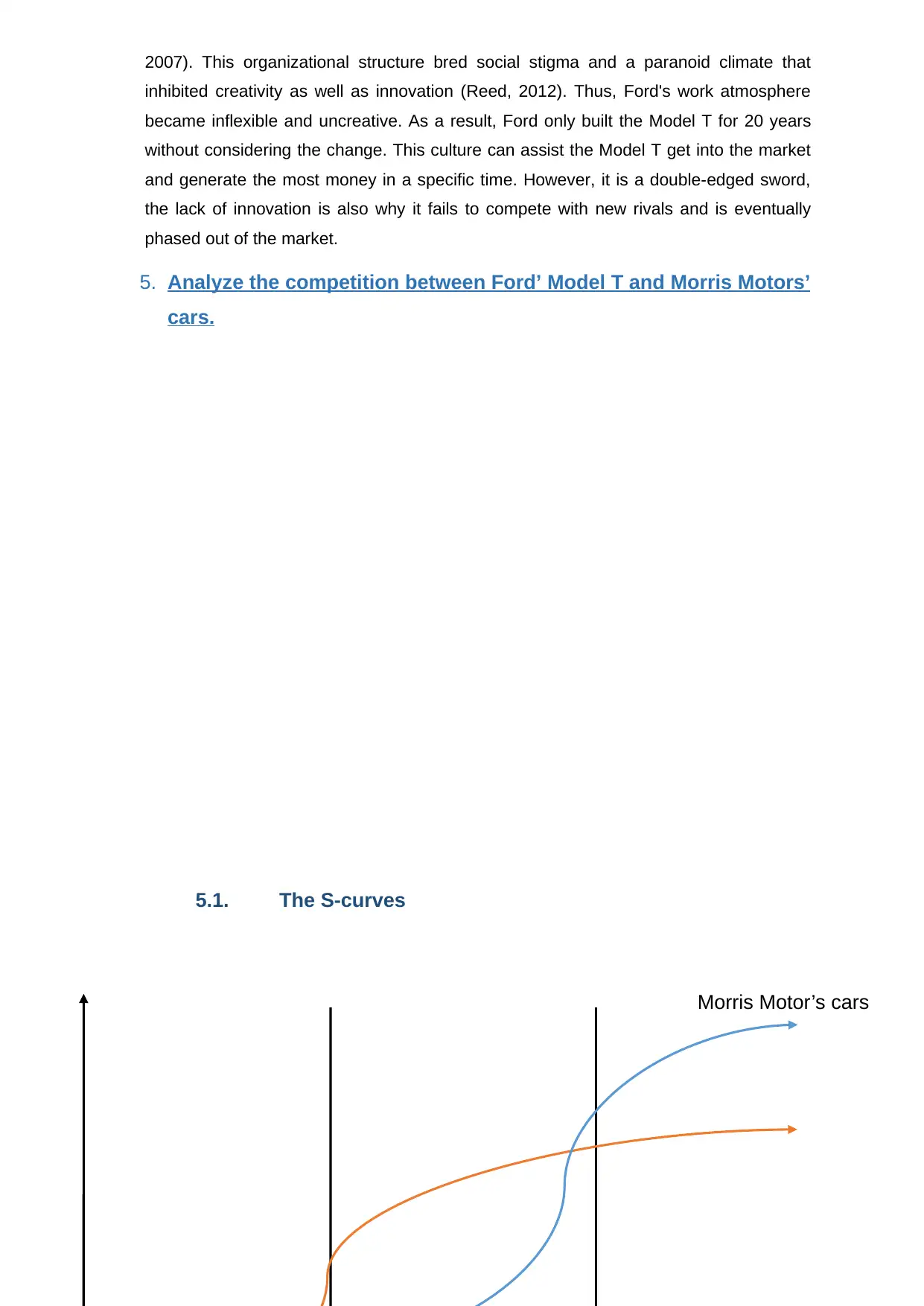
2007). This organizational structure bred social stigma and a paranoid climate that
inhibited creativity as well as innovation (Reed, 2012). Thus, Ford's work atmosphere
became inflexible and uncreative. As a result, Ford only built the Model T for 20 years
without considering the change. This culture can assist the Model T get into the market
and generate the most money in a specific time. However, it is a double-edged sword,
the lack of innovation is also why it fails to compete with new rivals and is eventually
phased out of the market.
5. Analyze the competition between Ford’ Model T and Morris Motors’
cars.
5.1. The S-curves
Morris Motor’s cars
inhibited creativity as well as innovation (Reed, 2012). Thus, Ford's work atmosphere
became inflexible and uncreative. As a result, Ford only built the Model T for 20 years
without considering the change. This culture can assist the Model T get into the market
and generate the most money in a specific time. However, it is a double-edged sword,
the lack of innovation is also why it fails to compete with new rivals and is eventually
phased out of the market.
5. Analyze the competition between Ford’ Model T and Morris Motors’
cars.
5.1. The S-curves
Morris Motor’s cars
Secure Best Marks with AI Grader
Need help grading? Try our AI Grader for instant feedback on your assignments.
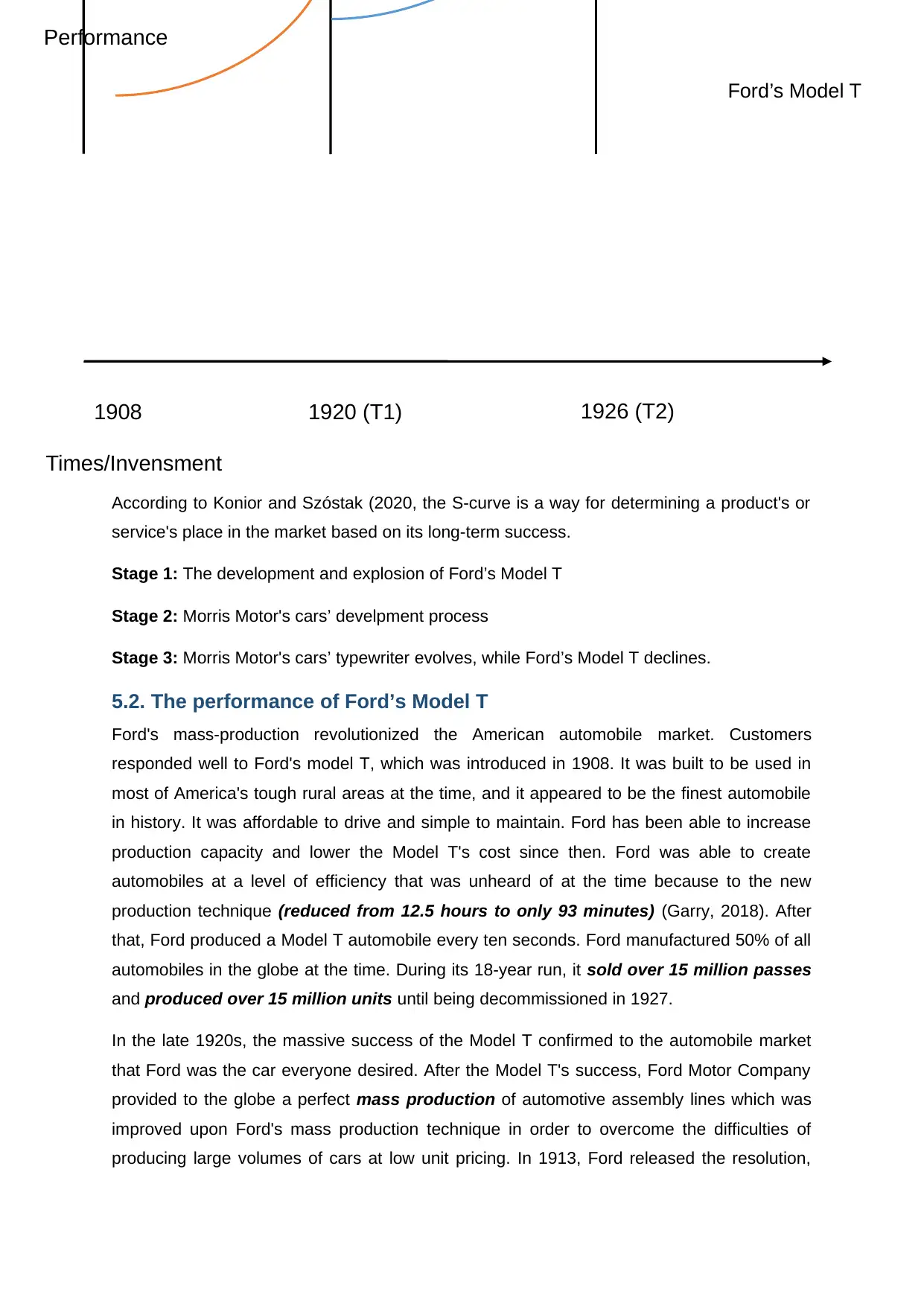
According to Konior and Szóstak (2020, the S-curve is a way for determining a product's or
service's place in the market based on its long-term success.
Stage 1: The development and explosion of Ford’s Model T
Stage 2: Morris Motor's cars’ develpment process
Stage 3: Morris Motor's cars’ typewriter evolves, while Ford’s Model T declines.
5.2. The performance of Ford’s Model T
Ford's mass-production revolutionized the American automobile market. Customers
responded well to Ford's model T, which was introduced in 1908. It was built to be used in
most of America's tough rural areas at the time, and it appeared to be the finest automobile
in history. It was affordable to drive and simple to maintain. Ford has been able to increase
production capacity and lower the Model T's cost since then. Ford was able to create
automobiles at a level of efficiency that was unheard of at the time because to the new
production technique (reduced from 12.5 hours to only 93 minutes) (Garry, 2018). After
that, Ford produced a Model T automobile every ten seconds. Ford manufactured 50% of all
automobiles in the globe at the time. During its 18-year run, it sold over 15 million passes
and produced over 15 million units until being decommissioned in 1927.
In the late 1920s, the massive success of the Model T confirmed to the automobile market
that Ford was the car everyone desired. After the Model T's success, Ford Motor Company
provided to the globe a perfect mass production of automotive assembly lines which was
improved upon Ford's mass production technique in order to overcome the difficulties of
producing large volumes of cars at low unit pricing. In 1913, Ford released the resolution,
Performance
Times/Invensment
1920 (T1) 1926 (T2)
Ford’s Model T
1908
service's place in the market based on its long-term success.
Stage 1: The development and explosion of Ford’s Model T
Stage 2: Morris Motor's cars’ develpment process
Stage 3: Morris Motor's cars’ typewriter evolves, while Ford’s Model T declines.
5.2. The performance of Ford’s Model T
Ford's mass-production revolutionized the American automobile market. Customers
responded well to Ford's model T, which was introduced in 1908. It was built to be used in
most of America's tough rural areas at the time, and it appeared to be the finest automobile
in history. It was affordable to drive and simple to maintain. Ford has been able to increase
production capacity and lower the Model T's cost since then. Ford was able to create
automobiles at a level of efficiency that was unheard of at the time because to the new
production technique (reduced from 12.5 hours to only 93 minutes) (Garry, 2018). After
that, Ford produced a Model T automobile every ten seconds. Ford manufactured 50% of all
automobiles in the globe at the time. During its 18-year run, it sold over 15 million passes
and produced over 15 million units until being decommissioned in 1927.
In the late 1920s, the massive success of the Model T confirmed to the automobile market
that Ford was the car everyone desired. After the Model T's success, Ford Motor Company
provided to the globe a perfect mass production of automotive assembly lines which was
improved upon Ford's mass production technique in order to overcome the difficulties of
producing large volumes of cars at low unit pricing. In 1913, Ford released the resolution,
Performance
Times/Invensment
1920 (T1) 1926 (T2)
Ford’s Model T
1908
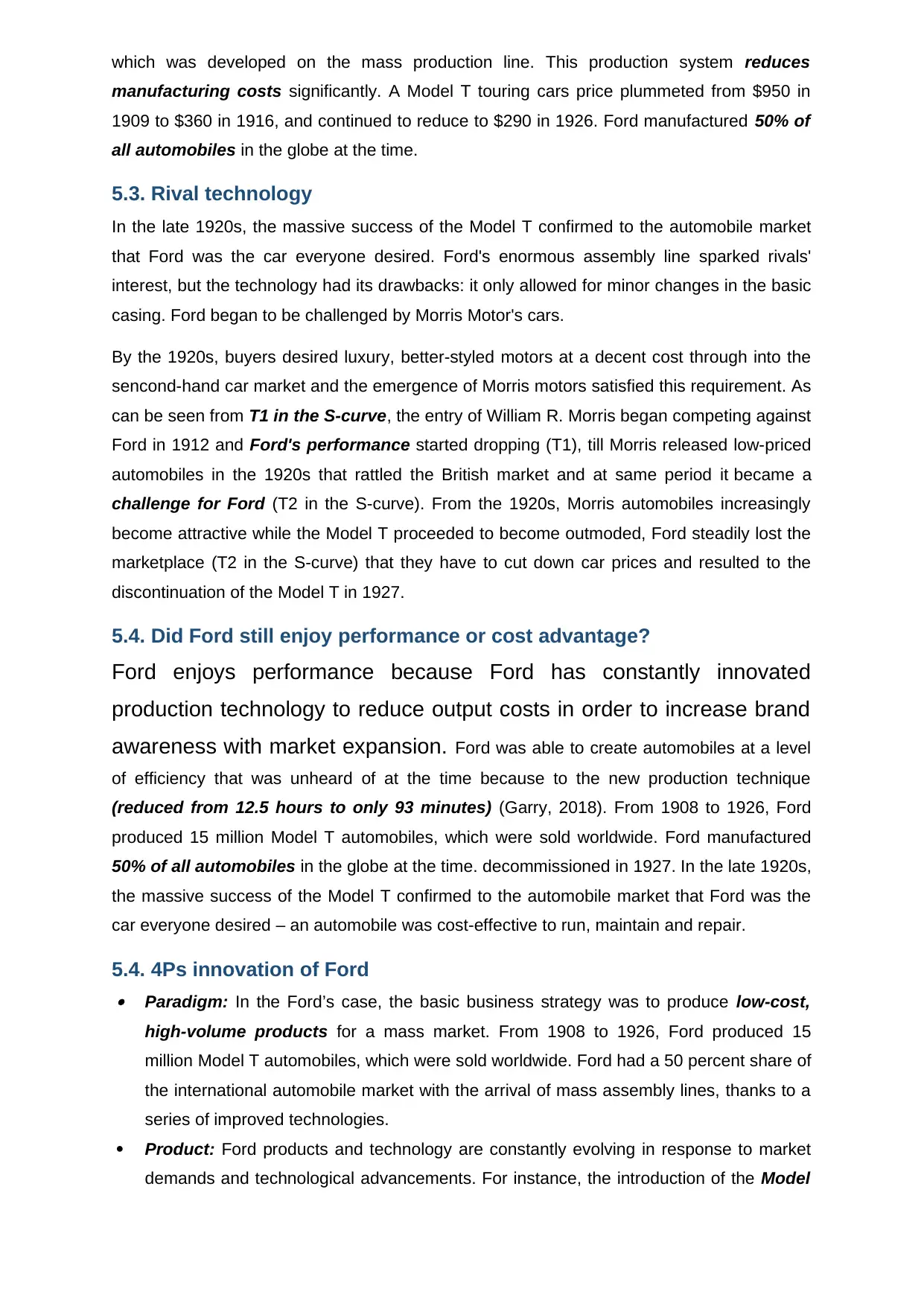
which was developed on the mass production line. This production system reduces
manufacturing costs significantly. A Model T touring cars price plummeted from $950 in
1909 to $360 in 1916, and continued to reduce to $290 in 1926. Ford manufactured 50% of
all automobiles in the globe at the time.
5.3. Rival technology
In the late 1920s, the massive success of the Model T confirmed to the automobile market
that Ford was the car everyone desired. Ford's enormous assembly line sparked rivals'
interest, but the technology had its drawbacks: it only allowed for minor changes in the basic
casing. Ford began to be challenged by Morris Motor's cars.
By the 1920s, buyers desired luxury, better-styled motors at a decent cost through into the
sencond-hand car market and the emergence of Morris motors satisfied this requirement. As
can be seen from T1 in the S-curve, the entry of William R. Morris began competing against
Ford in 1912 and Ford's performance started dropping (T1), till Morris released low-priced
automobiles in the 1920s that rattled the British market and at same period it became a
challenge for Ford (T2 in the S-curve). From the 1920s, Morris automobiles increasingly
become attractive while the Model T proceeded to become outmoded, Ford steadily lost the
marketplace (T2 in the S-curve) that they have to cut down car prices and resulted to the
discontinuation of the Model T in 1927.
5.4. Did Ford still enjoy performance or cost advantage?
Ford enjoys performance because Ford has constantly innovated
production technology to reduce output costs in order to increase brand
awareness with market expansion. Ford was able to create automobiles at a level
of efficiency that was unheard of at the time because to the new production technique
(reduced from 12.5 hours to only 93 minutes) (Garry, 2018). From 1908 to 1926, Ford
produced 15 million Model T automobiles, which were sold worldwide. Ford manufactured
50% of all automobiles in the globe at the time. decommissioned in 1927. In the late 1920s,
the massive success of the Model T confirmed to the automobile market that Ford was the
car everyone desired – an automobile was cost-effective to run, maintain and repair.
5.4. 4Ps innovation of Ford Paradigm: In the Ford’s case, the basic business strategy was to produce low-cost,
high-volume products for a mass market. From 1908 to 1926, Ford produced 15
million Model T automobiles, which were sold worldwide. Ford had a 50 percent share of
the international automobile market with the arrival of mass assembly lines, thanks to a
series of improved technologies.
Product: Ford products and technology are constantly evolving in response to market
demands and technological advancements. For instance, the introduction of the Model
manufacturing costs significantly. A Model T touring cars price plummeted from $950 in
1909 to $360 in 1916, and continued to reduce to $290 in 1926. Ford manufactured 50% of
all automobiles in the globe at the time.
5.3. Rival technology
In the late 1920s, the massive success of the Model T confirmed to the automobile market
that Ford was the car everyone desired. Ford's enormous assembly line sparked rivals'
interest, but the technology had its drawbacks: it only allowed for minor changes in the basic
casing. Ford began to be challenged by Morris Motor's cars.
By the 1920s, buyers desired luxury, better-styled motors at a decent cost through into the
sencond-hand car market and the emergence of Morris motors satisfied this requirement. As
can be seen from T1 in the S-curve, the entry of William R. Morris began competing against
Ford in 1912 and Ford's performance started dropping (T1), till Morris released low-priced
automobiles in the 1920s that rattled the British market and at same period it became a
challenge for Ford (T2 in the S-curve). From the 1920s, Morris automobiles increasingly
become attractive while the Model T proceeded to become outmoded, Ford steadily lost the
marketplace (T2 in the S-curve) that they have to cut down car prices and resulted to the
discontinuation of the Model T in 1927.
5.4. Did Ford still enjoy performance or cost advantage?
Ford enjoys performance because Ford has constantly innovated
production technology to reduce output costs in order to increase brand
awareness with market expansion. Ford was able to create automobiles at a level
of efficiency that was unheard of at the time because to the new production technique
(reduced from 12.5 hours to only 93 minutes) (Garry, 2018). From 1908 to 1926, Ford
produced 15 million Model T automobiles, which were sold worldwide. Ford manufactured
50% of all automobiles in the globe at the time. decommissioned in 1927. In the late 1920s,
the massive success of the Model T confirmed to the automobile market that Ford was the
car everyone desired – an automobile was cost-effective to run, maintain and repair.
5.4. 4Ps innovation of Ford Paradigm: In the Ford’s case, the basic business strategy was to produce low-cost,
high-volume products for a mass market. From 1908 to 1926, Ford produced 15
million Model T automobiles, which were sold worldwide. Ford had a 50 percent share of
the international automobile market with the arrival of mass assembly lines, thanks to a
series of improved technologies.
Product: Ford products and technology are constantly evolving in response to market
demands and technological advancements. For instance, the introduction of the Model
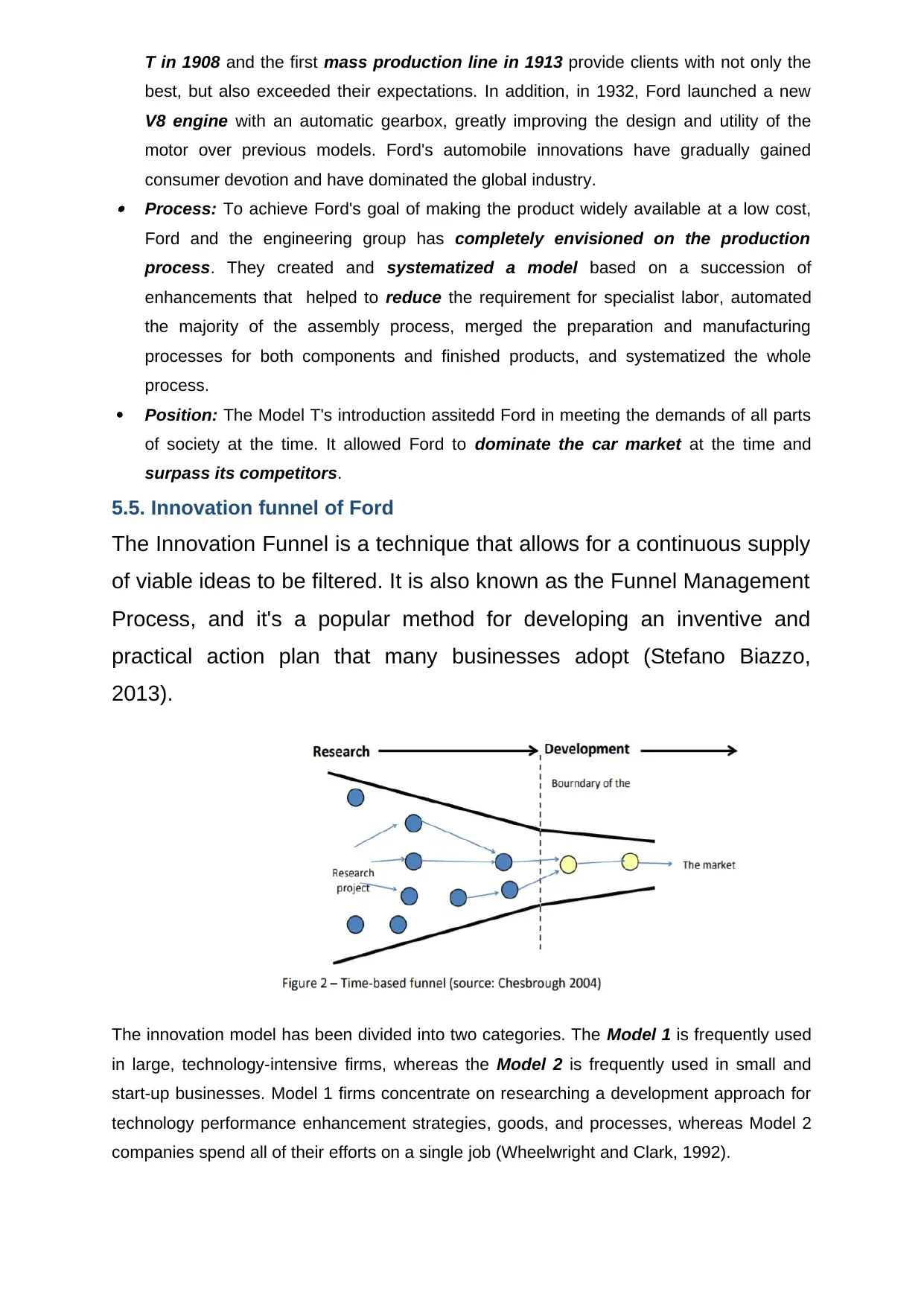
T in 1908 and the first mass production line in 1913 provide clients with not only the
best, but also exceeded their expectations. In addition, in 1932, Ford launched a new
V8 engine with an automatic gearbox, greatly improving the design and utility of the
motor over previous models. Ford's automobile innovations have gradually gained
consumer devotion and have dominated the global industry. Process: To achieve Ford's goal of making the product widely available at a low cost,
Ford and the engineering group has completely envisioned on the production
process. They created and systematized a model based on a succession of
enhancements that helped to reduce the requirement for specialist labor, automated
the majority of the assembly process, merged the preparation and manufacturing
processes for both components and finished products, and systematized the whole
process.
Position: The Model T's introduction assitedd Ford in meeting the demands of all parts
of society at the time. It allowed Ford to dominate the car market at the time and
surpass its competitors.
5.5. Innovation funnel of Ford
The Innovation Funnel is a technique that allows for a continuous supply
of viable ideas to be filtered. It is also known as the Funnel Management
Process, and it's a popular method for developing an inventive and
practical action plan that many businesses adopt (Stefano Biazzo,
2013).
The innovation model has been divided into two categories. The Model 1 is frequently used
in large, technology-intensive firms, whereas the Model 2 is frequently used in small and
start-up businesses. Model 1 firms concentrate on researching a development approach for
technology performance enhancement strategies, goods, and processes, whereas Model 2
companies spend all of their efforts on a single job (Wheelwright and Clark, 1992).
best, but also exceeded their expectations. In addition, in 1932, Ford launched a new
V8 engine with an automatic gearbox, greatly improving the design and utility of the
motor over previous models. Ford's automobile innovations have gradually gained
consumer devotion and have dominated the global industry. Process: To achieve Ford's goal of making the product widely available at a low cost,
Ford and the engineering group has completely envisioned on the production
process. They created and systematized a model based on a succession of
enhancements that helped to reduce the requirement for specialist labor, automated
the majority of the assembly process, merged the preparation and manufacturing
processes for both components and finished products, and systematized the whole
process.
Position: The Model T's introduction assitedd Ford in meeting the demands of all parts
of society at the time. It allowed Ford to dominate the car market at the time and
surpass its competitors.
5.5. Innovation funnel of Ford
The Innovation Funnel is a technique that allows for a continuous supply
of viable ideas to be filtered. It is also known as the Funnel Management
Process, and it's a popular method for developing an inventive and
practical action plan that many businesses adopt (Stefano Biazzo,
2013).
The innovation model has been divided into two categories. The Model 1 is frequently used
in large, technology-intensive firms, whereas the Model 2 is frequently used in small and
start-up businesses. Model 1 firms concentrate on researching a development approach for
technology performance enhancement strategies, goods, and processes, whereas Model 2
companies spend all of their efforts on a single job (Wheelwright and Clark, 1992).
Paraphrase This Document
Need a fresh take? Get an instant paraphrase of this document with our AI Paraphraser
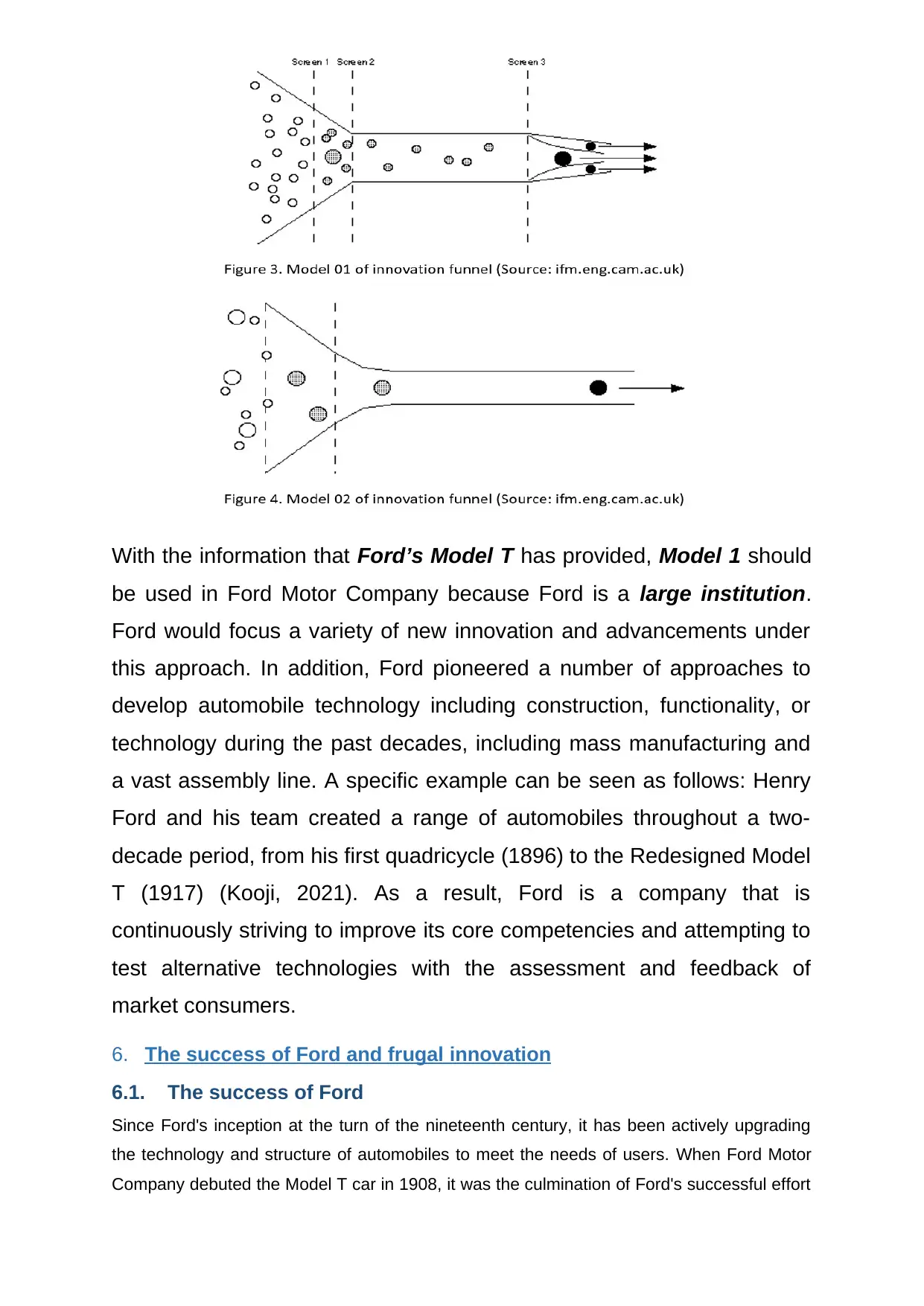
With the information that Ford’s Model T has provided, Model 1 should
be used in Ford Motor Company because Ford is a large institution.
Ford would focus a variety of new innovation and advancements under
this approach. In addition, Ford pioneered a number of approaches to
develop automobile technology including construction, functionality, or
technology during the past decades, including mass manufacturing and
a vast assembly line. A specific example can be seen as follows: Henry
Ford and his team created a range of automobiles throughout a two-
decade period, from his first quadricycle (1896) to the Redesigned Model
T (1917) (Kooji, 2021). As a result, Ford is a company that is
continuously striving to improve its core competencies and attempting to
test alternative technologies with the assessment and feedback of
market consumers.
6. The success of Ford and frugal innovation
6.1. The success of Ford
Since Ford's inception at the turn of the nineteenth century, it has been actively upgrading
the technology and structure of automobiles to meet the needs of users. When Ford Motor
Company debuted the Model T car in 1908, it was the culmination of Ford's successful effort
be used in Ford Motor Company because Ford is a large institution.
Ford would focus a variety of new innovation and advancements under
this approach. In addition, Ford pioneered a number of approaches to
develop automobile technology including construction, functionality, or
technology during the past decades, including mass manufacturing and
a vast assembly line. A specific example can be seen as follows: Henry
Ford and his team created a range of automobiles throughout a two-
decade period, from his first quadricycle (1896) to the Redesigned Model
T (1917) (Kooji, 2021). As a result, Ford is a company that is
continuously striving to improve its core competencies and attempting to
test alternative technologies with the assessment and feedback of
market consumers.
6. The success of Ford and frugal innovation
6.1. The success of Ford
Since Ford's inception at the turn of the nineteenth century, it has been actively upgrading
the technology and structure of automobiles to meet the needs of users. When Ford Motor
Company debuted the Model T car in 1908, it was the culmination of Ford's successful effort

to create an affordable, effective, and dependable mode of automobile. This has made it
easier for middle-income people to own a car. Retailers received 15,000 bookings
immediately after its debut (almost double the following year's unit income, according to Bob
Casey, former Curator of Transportation at Ford).
With determination to maintain the position and advantage, that resolve had motivated Ford
to build a moving assembly line in 1913. As a result, a development that dramatically
reduced operating expenses. In 1926, the Model T could be purchased for less than $300,
and Ford controlled half of the automotive market.
6.2. Technology innovation management of Ford
Ford has expertly regulated and enhanced its technical innovation to maintain its position
despite the emergence of competitors, owing to its dominance and soaring leadership. To
begin with, Ford has selected the proper client niche from the beginning. The car's large
shape is suitable for lengthy journeys and improves both safety and cost effectiveness
(Thien Huong, Sombat, 2016). Due to the distinctiveness of each model, Ford has been
satisfying the desires of customers who have been yearning for something similar since
the very first automobiles were created, for example the Model T in 1908. Later, Ford
modernized and produced a variety of models with different styles, but the company is still
regarded as one of the most prestigious automobile manufacturers.
6.3. Frugal innovation
a, Definition
According to McGee (2014), frugal innovation is the practice of breaking down product
materials and manufacturing processes into their most basic components in order to
reorganize both goods and processes to be more effective and cost-effective. Additionally,
economic concepts of replacements might be used to illustrate thrifty innovation. It works
well when the cost of replacing obsolete materials with current, more technically advanced
equipment is less than the cost of building the prototype from scratch.
b, The given context of Ford Motor Company
In Ford's case, the company has emphasized affordability. During the revolution, Ford rose
to prominence as a leader in technical innovation. In addition to iconic items at premium
prices, Ford continues to push further new products, such as the Model T upgrade. In the
early nineteenth century, the introduction of the Model T allowed Ford to meet the
requirements of consumers. Even by the 1913s, Ford's mass production processes had
reduced car prices to their lowest point in 1926 (a Model T touring cars price plummeted
from $950 in 1909 to $360 in 1916, and continued to reduce to $290 in 1926). This
demonstrates Ford's focus on consumer affordability, as evidenced by revolutionary
easier for middle-income people to own a car. Retailers received 15,000 bookings
immediately after its debut (almost double the following year's unit income, according to Bob
Casey, former Curator of Transportation at Ford).
With determination to maintain the position and advantage, that resolve had motivated Ford
to build a moving assembly line in 1913. As a result, a development that dramatically
reduced operating expenses. In 1926, the Model T could be purchased for less than $300,
and Ford controlled half of the automotive market.
6.2. Technology innovation management of Ford
Ford has expertly regulated and enhanced its technical innovation to maintain its position
despite the emergence of competitors, owing to its dominance and soaring leadership. To
begin with, Ford has selected the proper client niche from the beginning. The car's large
shape is suitable for lengthy journeys and improves both safety and cost effectiveness
(Thien Huong, Sombat, 2016). Due to the distinctiveness of each model, Ford has been
satisfying the desires of customers who have been yearning for something similar since
the very first automobiles were created, for example the Model T in 1908. Later, Ford
modernized and produced a variety of models with different styles, but the company is still
regarded as one of the most prestigious automobile manufacturers.
6.3. Frugal innovation
a, Definition
According to McGee (2014), frugal innovation is the practice of breaking down product
materials and manufacturing processes into their most basic components in order to
reorganize both goods and processes to be more effective and cost-effective. Additionally,
economic concepts of replacements might be used to illustrate thrifty innovation. It works
well when the cost of replacing obsolete materials with current, more technically advanced
equipment is less than the cost of building the prototype from scratch.
b, The given context of Ford Motor Company
In Ford's case, the company has emphasized affordability. During the revolution, Ford rose
to prominence as a leader in technical innovation. In addition to iconic items at premium
prices, Ford continues to push further new products, such as the Model T upgrade. In the
early nineteenth century, the introduction of the Model T allowed Ford to meet the
requirements of consumers. Even by the 1913s, Ford's mass production processes had
reduced car prices to their lowest point in 1926 (a Model T touring cars price plummeted
from $950 in 1909 to $360 in 1916, and continued to reduce to $290 in 1926). This
demonstrates Ford's focus on consumer affordability, as evidenced by revolutionary
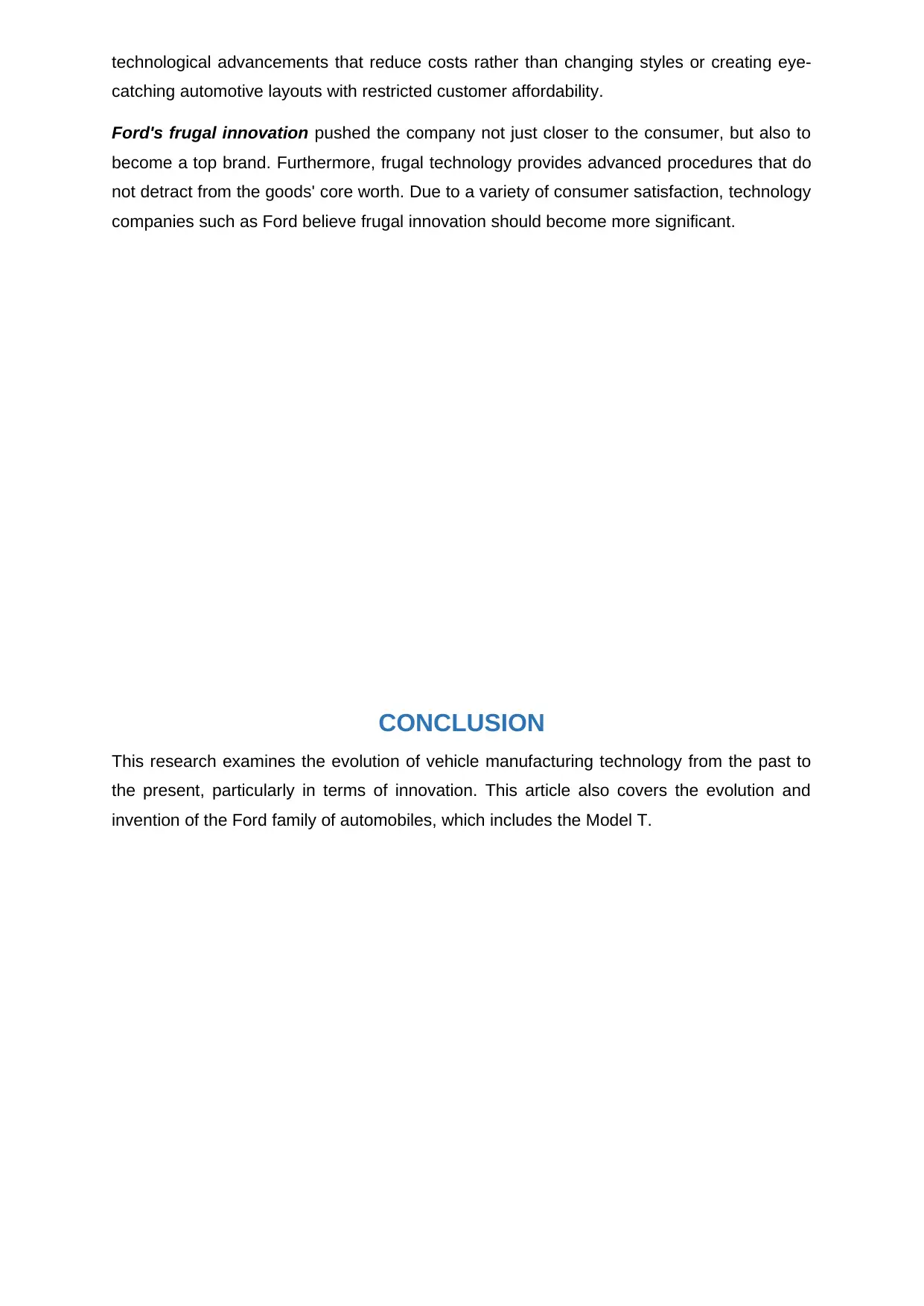
technological advancements that reduce costs rather than changing styles or creating eye-
catching automotive layouts with restricted customer affordability.
Ford's frugal innovation pushed the company not just closer to the consumer, but also to
become a top brand. Furthermore, frugal technology provides advanced procedures that do
not detract from the goods' core worth. Due to a variety of consumer satisfaction, technology
companies such as Ford believe frugal innovation should become more significant.
CONCLUSION
This research examines the evolution of vehicle manufacturing technology from the past to
the present, particularly in terms of innovation. This article also covers the evolution and
invention of the Ford family of automobiles, which includes the Model T.
catching automotive layouts with restricted customer affordability.
Ford's frugal innovation pushed the company not just closer to the consumer, but also to
become a top brand. Furthermore, frugal technology provides advanced procedures that do
not detract from the goods' core worth. Due to a variety of consumer satisfaction, technology
companies such as Ford believe frugal innovation should become more significant.
CONCLUSION
This research examines the evolution of vehicle manufacturing technology from the past to
the present, particularly in terms of innovation. This article also covers the evolution and
invention of the Ford family of automobiles, which includes the Model T.
Secure Best Marks with AI Grader
Need help grading? Try our AI Grader for instant feedback on your assignments.
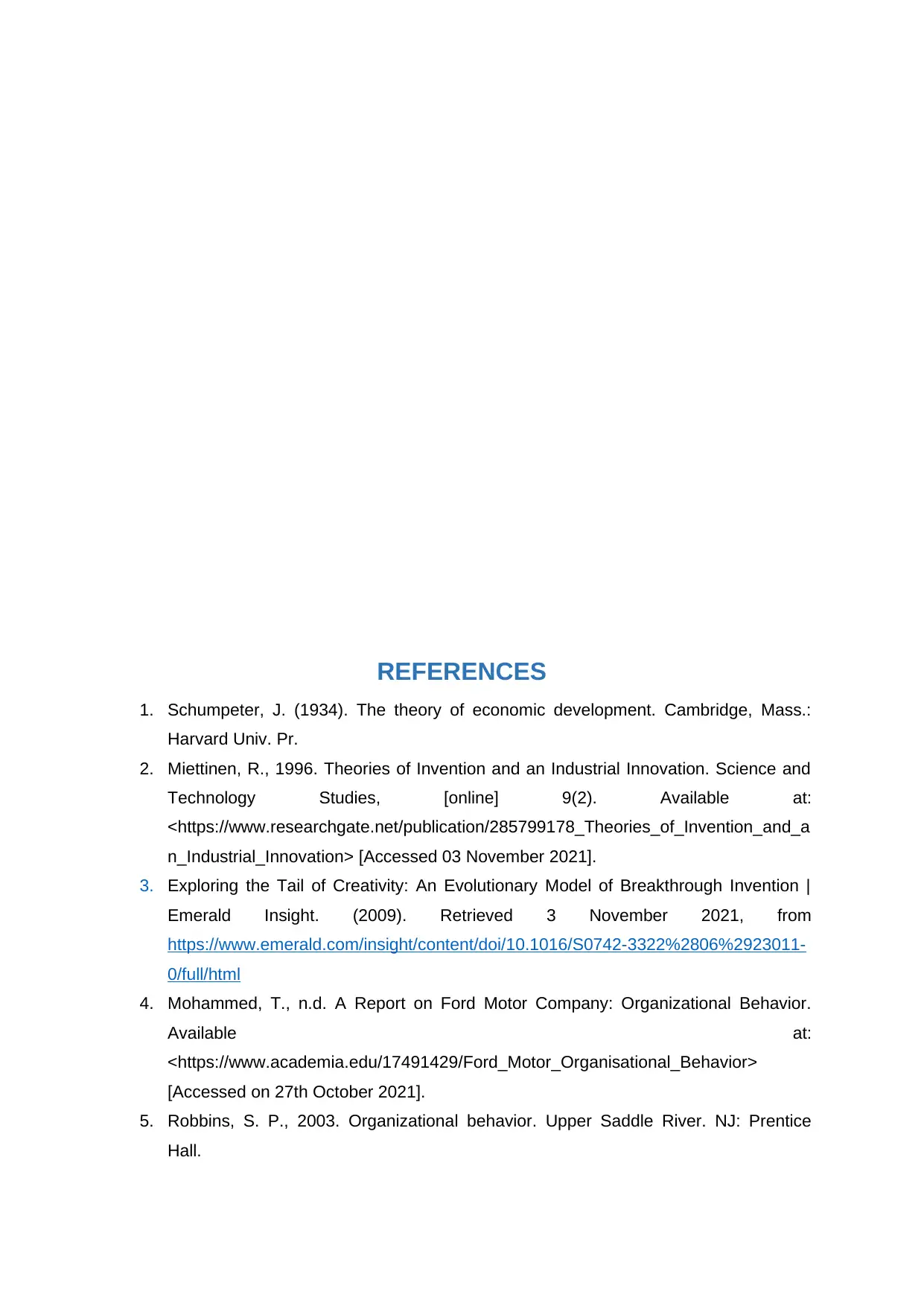
REFERENCES
1. Schumpeter, J. (1934). The theory of economic development. Cambridge, Mass.:
Harvard Univ. Pr.
2. Miettinen, R., 1996. Theories of Invention and an Industrial Innovation. Science and
Technology Studies, [online] 9(2). Available at:
<https://www.researchgate.net/publication/285799178_Theories_of_Invention_and_a
n_Industrial_Innovation> [Accessed 03 November 2021].
3. Exploring the Tail of Creativity: An Evolutionary Model of Breakthrough Invention |
Emerald Insight. (2009). Retrieved 3 November 2021, from
https://www.emerald.com/insight/content/doi/10.1016/S0742-3322%2806%2923011-
0/full/html
4. Mohammed, T., n.d. A Report on Ford Motor Company: Organizational Behavior.
Available at:
<https://www.academia.edu/17491429/Ford_Motor_Organisational_Behavior>
[Accessed on 27th October 2021].
5. Robbins, S. P., 2003. Organizational behavior. Upper Saddle River. NJ: Prentice
Hall.
1. Schumpeter, J. (1934). The theory of economic development. Cambridge, Mass.:
Harvard Univ. Pr.
2. Miettinen, R., 1996. Theories of Invention and an Industrial Innovation. Science and
Technology Studies, [online] 9(2). Available at:
<https://www.researchgate.net/publication/285799178_Theories_of_Invention_and_a
n_Industrial_Innovation> [Accessed 03 November 2021].
3. Exploring the Tail of Creativity: An Evolutionary Model of Breakthrough Invention |
Emerald Insight. (2009). Retrieved 3 November 2021, from
https://www.emerald.com/insight/content/doi/10.1016/S0742-3322%2806%2923011-
0/full/html
4. Mohammed, T., n.d. A Report on Ford Motor Company: Organizational Behavior.
Available at:
<https://www.academia.edu/17491429/Ford_Motor_Organisational_Behavior>
[Accessed on 27th October 2021].
5. Robbins, S. P., 2003. Organizational behavior. Upper Saddle River. NJ: Prentice
Hall.
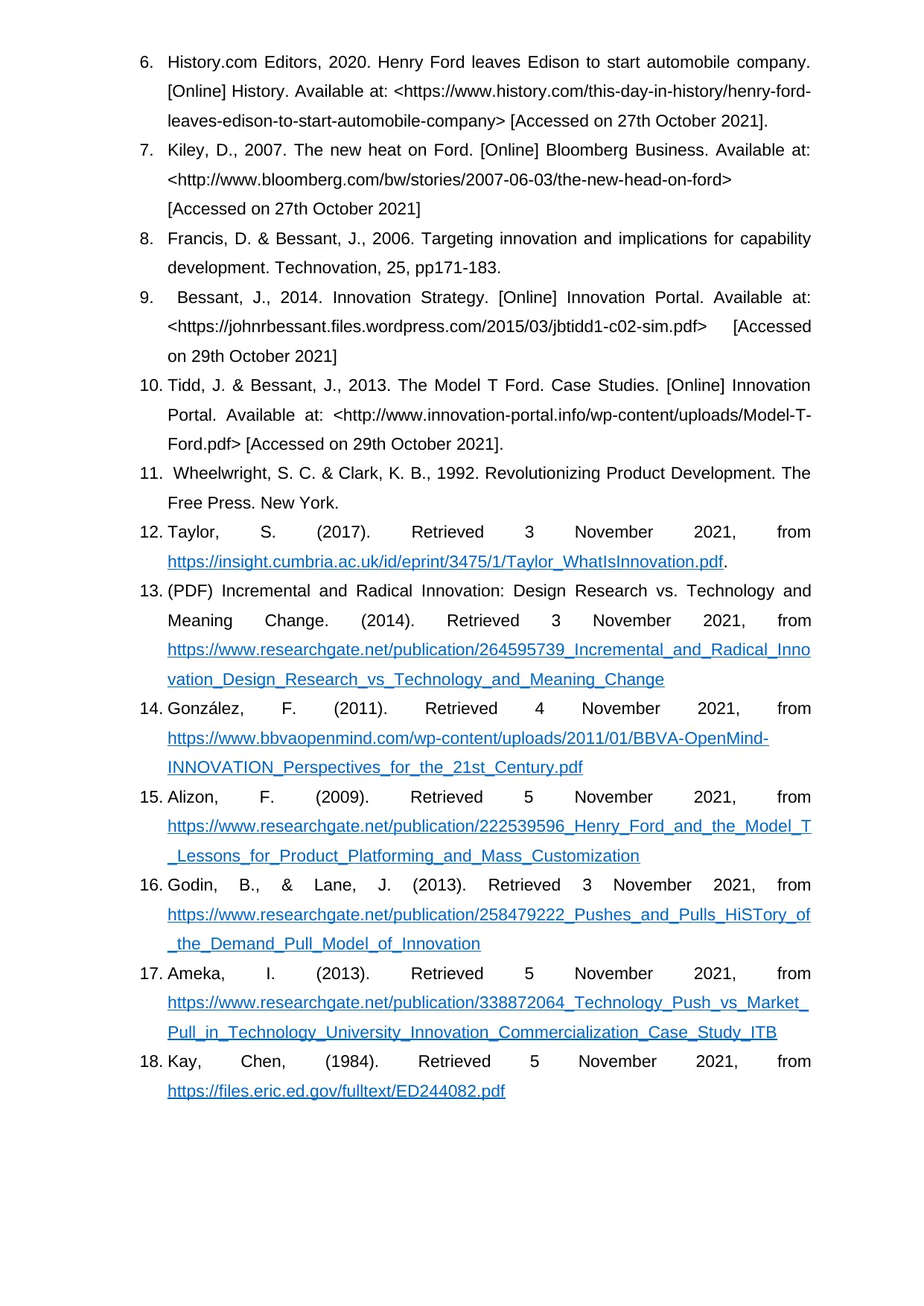
6. History.com Editors, 2020. Henry Ford leaves Edison to start automobile company.
[Online] History. Available at: <https://www.history.com/this-day-in-history/henry-ford-
leaves-edison-to-start-automobile-company> [Accessed on 27th October 2021].
7. Kiley, D., 2007. The new heat on Ford. [Online] Bloomberg Business. Available at:
<http://www.bloomberg.com/bw/stories/2007-06-03/the-new-head-on-ford>
[Accessed on 27th October 2021]
8. Francis, D. & Bessant, J., 2006. Targeting innovation and implications for capability
development. Technovation, 25, pp171-183.
9. Bessant, J., 2014. Innovation Strategy. [Online] Innovation Portal. Available at:
<https://johnrbessant.files.wordpress.com/2015/03/jbtidd1-c02-sim.pdf> [Accessed
on 29th October 2021]
10. Tidd, J. & Bessant, J., 2013. The Model T Ford. Case Studies. [Online] Innovation
Portal. Available at: <http://www.innovation-portal.info/wp-content/uploads/Model-T-
Ford.pdf> [Accessed on 29th October 2021].
11. Wheelwright, S. C. & Clark, K. B., 1992. Revolutionizing Product Development. The
Free Press. New York.
12. Taylor, S. (2017). Retrieved 3 November 2021, from
https://insight.cumbria.ac.uk/id/eprint/3475/1/Taylor_WhatIsInnovation.pdf.
13. (PDF) Incremental and Radical Innovation: Design Research vs. Technology and
Meaning Change. (2014). Retrieved 3 November 2021, from
https://www.researchgate.net/publication/264595739_Incremental_and_Radical_Inno
vation_Design_Research_vs_Technology_and_Meaning_Change
14. González, F. (2011). Retrieved 4 November 2021, from
https://www.bbvaopenmind.com/wp-content/uploads/2011/01/BBVA-OpenMind-
INNOVATION_Perspectives_for_the_21st_Century.pdf
15. Alizon, F. (2009). Retrieved 5 November 2021, from
https://www.researchgate.net/publication/222539596_Henry_Ford_and_the_Model_T
_Lessons_for_Product_Platforming_and_Mass_Customization
16. Godin, B., & Lane, J. (2013). Retrieved 3 November 2021, from
https://www.researchgate.net/publication/258479222_Pushes_and_Pulls_HiSTory_of
_the_Demand_Pull_Model_of_Innovation
17. Ameka, I. (2013). Retrieved 5 November 2021, from
https://www.researchgate.net/publication/338872064_Technology_Push_vs_Market_
Pull_in_Technology_University_Innovation_Commercialization_Case_Study_ITB
18. Kay, Chen, (1984). Retrieved 5 November 2021, from
https://files.eric.ed.gov/fulltext/ED244082.pdf
[Online] History. Available at: <https://www.history.com/this-day-in-history/henry-ford-
leaves-edison-to-start-automobile-company> [Accessed on 27th October 2021].
7. Kiley, D., 2007. The new heat on Ford. [Online] Bloomberg Business. Available at:
<http://www.bloomberg.com/bw/stories/2007-06-03/the-new-head-on-ford>
[Accessed on 27th October 2021]
8. Francis, D. & Bessant, J., 2006. Targeting innovation and implications for capability
development. Technovation, 25, pp171-183.
9. Bessant, J., 2014. Innovation Strategy. [Online] Innovation Portal. Available at:
<https://johnrbessant.files.wordpress.com/2015/03/jbtidd1-c02-sim.pdf> [Accessed
on 29th October 2021]
10. Tidd, J. & Bessant, J., 2013. The Model T Ford. Case Studies. [Online] Innovation
Portal. Available at: <http://www.innovation-portal.info/wp-content/uploads/Model-T-
Ford.pdf> [Accessed on 29th October 2021].
11. Wheelwright, S. C. & Clark, K. B., 1992. Revolutionizing Product Development. The
Free Press. New York.
12. Taylor, S. (2017). Retrieved 3 November 2021, from
https://insight.cumbria.ac.uk/id/eprint/3475/1/Taylor_WhatIsInnovation.pdf.
13. (PDF) Incremental and Radical Innovation: Design Research vs. Technology and
Meaning Change. (2014). Retrieved 3 November 2021, from
https://www.researchgate.net/publication/264595739_Incremental_and_Radical_Inno
vation_Design_Research_vs_Technology_and_Meaning_Change
14. González, F. (2011). Retrieved 4 November 2021, from
https://www.bbvaopenmind.com/wp-content/uploads/2011/01/BBVA-OpenMind-
INNOVATION_Perspectives_for_the_21st_Century.pdf
15. Alizon, F. (2009). Retrieved 5 November 2021, from
https://www.researchgate.net/publication/222539596_Henry_Ford_and_the_Model_T
_Lessons_for_Product_Platforming_and_Mass_Customization
16. Godin, B., & Lane, J. (2013). Retrieved 3 November 2021, from
https://www.researchgate.net/publication/258479222_Pushes_and_Pulls_HiSTory_of
_the_Demand_Pull_Model_of_Innovation
17. Ameka, I. (2013). Retrieved 5 November 2021, from
https://www.researchgate.net/publication/338872064_Technology_Push_vs_Market_
Pull_in_Technology_University_Innovation_Commercialization_Case_Study_ITB
18. Kay, Chen, (1984). Retrieved 5 November 2021, from
https://files.eric.ed.gov/fulltext/ED244082.pdf
1 out of 18
Related Documents
Your All-in-One AI-Powered Toolkit for Academic Success.
+13062052269
info@desklib.com
Available 24*7 on WhatsApp / Email
![[object Object]](/_next/static/media/star-bottom.7253800d.svg)
Unlock your academic potential
© 2024 | Zucol Services PVT LTD | All rights reserved.




